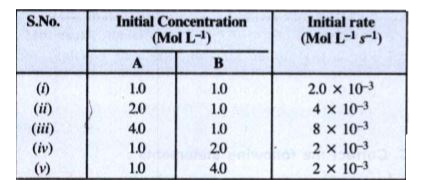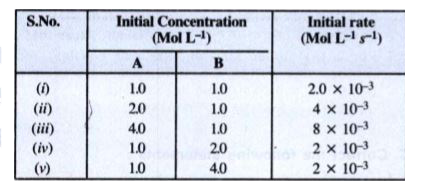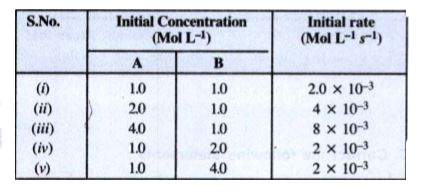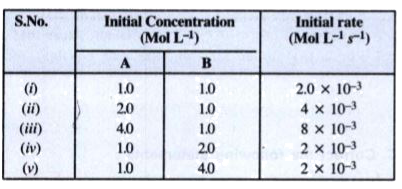Consider the reaction, .
The initial rate for different initial concentrations of the reactants are given below :

Calculate the rate constant.
For the given reaction, rate . After substituting the values of initial rates and initial concentrations, the value of x and y can be calculated. Then (x + y) will give the order of the reaction. For experiment (i)
For experiment (ii) ...(2)
For experiment (iii)
For experiment (iv)
For experiment (v)
Determination of x. In order to get the value of x, divide equation (2) by (1)
Determination of y. In order to get the value of y, divide equation (4) by (1)
rate constant,
Topper's Solved these Questions
- CHEMICAL KINETICSBook:ICSEChapter:CHEMICAL KINETICSExercise:ISC EXAMINATION QUESTIONS (PART-II (DESCRIPTIVE QUESTIONS ) )
Explore 51 Videos
- BIOMOLECULESBook:ICSEChapter:BIOMOLECULESExercise:ISC EXAMINATION QUSTIONS (PART-I)(DESCRIPTIVE QUESTIONS)
Explore 21 Videos
- CHEMISTRY IN EVERYDAY LIFEBook:ICSEChapter:CHEMISTRY IN EVERYDAY LIFEExercise:EXERCISE (PART - II (DESCRIPTIVE QUESTIONS) (LONG ANSWER QUESTIONS))
Explore 19 Videos
Similar Questions
Consider the reaction, A+B→C+D.
The initial rate for different initial concentrations of the reactants are given below :

Write the rate law equation.
View SolutionConsider the reaction, A+B→C+D.
The initial rate for different initial concentrations of the reactants are given below :

Write the rate law equation.
View SolutionConsider the reaction, A+B→C+D.
The initial rate for different initial concentrations of the reactants are given below :

Write the rate law equation.
View SolutionConsider the reaction, A+B→C+D.
The initial rate for different initial concentrations of the reactants are given below :

What is the overall order ?
View SolutionConsider the reaction, A+B→C+D.
The initial rate for different initial concentrations of the reactants are given below :

What is the overall order ?
View SolutionConsider the reaction, A+B→C+D.
The initial rate for different initial concentrations of the reactants are given below :

What is the overall order ?
View SolutionConsider the reaction, A+B→C+D.
The initial rate for different initial concentrations of the reactants are given below :

Suggest a possible mechanism.
View SolutionConsider the reaction, A+B→C+D.
The initial rate for different initial concentrations of the reactants are given below :

Suggest a possible mechanism.
View SolutionConsider the reaction, A+B→C+D.
The initial rate for different initial concentrations of the reactants are given below :

Suggest a possible mechanism.
View SolutionConsider the reaction, A+B→C+D.
The initial rate for different initial concentrations of the reactants are given below :

What are the orders with respect to A and B ?
View Solution

